2012 JEEP LIBERTY radiator cap
[x] Cancel search: radiator capPage 351 of 558
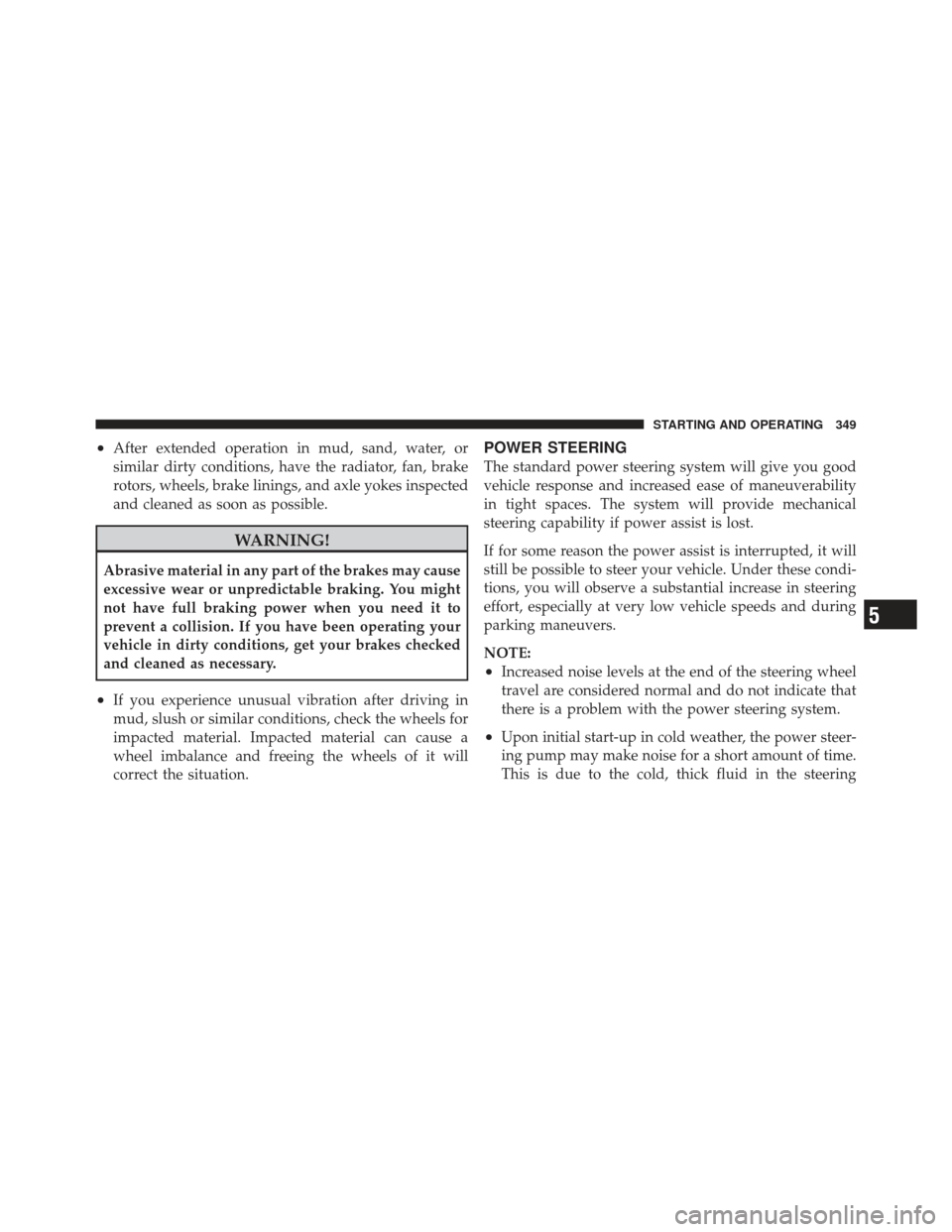
•After extended operation in mud, sand, water, or
similar dirty conditions, have the radiator, fan, brake
rotors, wheels, brake linings, and axle yokes inspected
and cleaned as soon as possible.
WARNING!
Abrasive material in any part of the brakes may cause
excessive wear or unpredictable braking. You might
not have full braking power when you need it to
prevent a collision. If you have been operating your
vehicle in dirty conditions, get your brakes checked
and cleaned as necessary.
•If you experience unusual vibration after driving in
mud, slush or similar conditions, check the wheels for
impacted material. Impacted material can cause a
wheel imbalance and freeing the wheels of it will
correct the situation.
POWER STEERING
The standard power steering system will give you good
vehicle response and increased ease of maneuverability
in tight spaces. The system will provide mechanical
steering capability if power assist is lost.
If for some reason the power assist is interrupted, it will
still be possible to steer your vehicle. Under these condi-
tions, you will observe a substantial increase in steering
effort, especially at very low vehicle speeds and during
parking maneuvers.
NOTE:
•Increased noise levels at the end of the steering wheel
travel are considered normal and do not indicate that
there is a problem with the power steering system.
•Upon initial start-up in cold weather, the power steer-
ing pump may make noise for a short amount of time.
This is due to the cold, thick fluid in the steering
5
STARTING AND OPERATING 349
Page 437 of 558
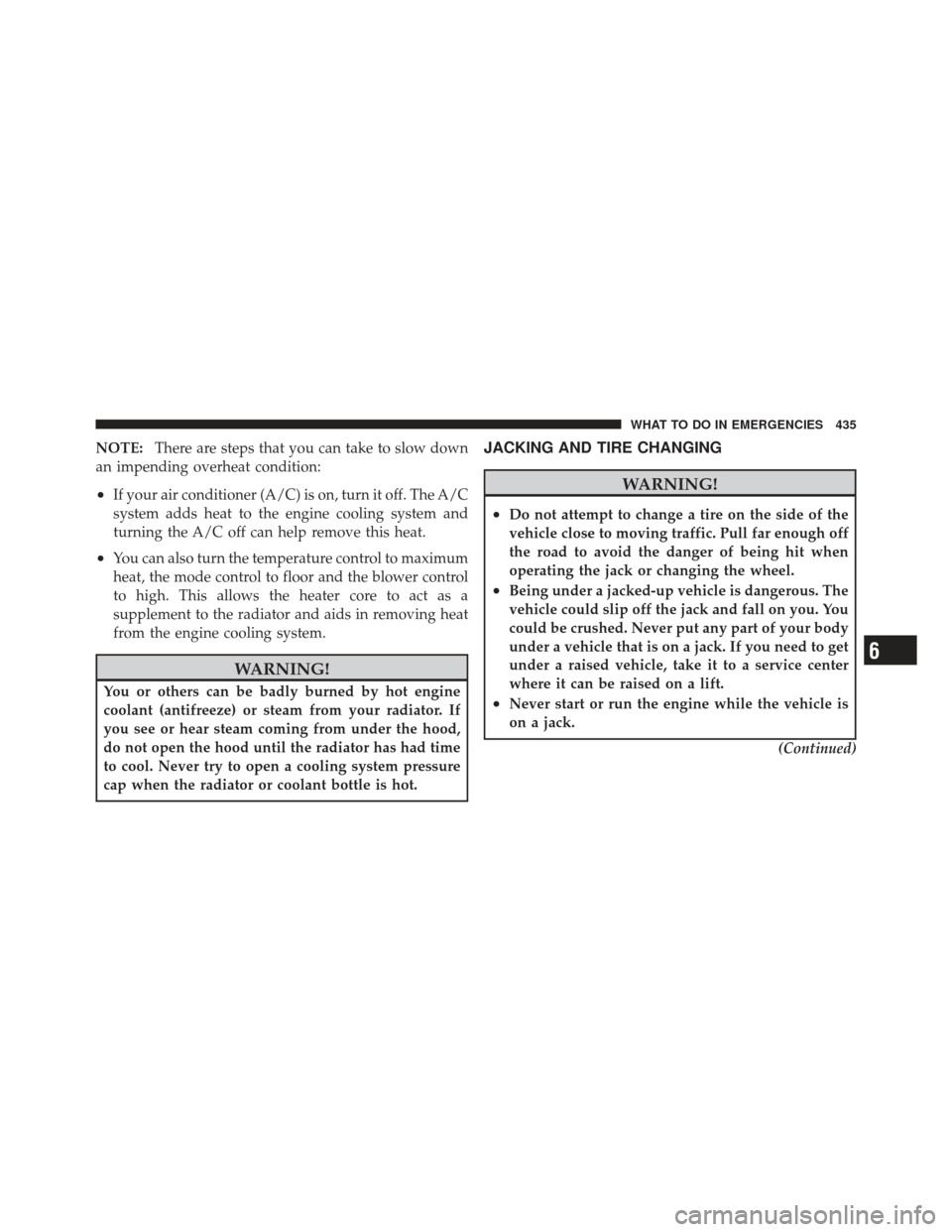
NOTE:There are steps that you can take to slow down
an impending overheat condition:
•If your air conditioner (A/C) is on, turn it off. The A/C
system adds heat to the engine cooling system and
turning the A/C off can help remove this heat.
•You can also turn the temperature control to maximum
heat, the mode control to floor and the blower control
to high. This allows the heater core to act as a
supplement to the radiator and aids in removing heat
from the engine cooling system.
WARNING!
You or others can be badly burned by hot engine
coolant (antifreeze) or steam from your radiator. If
you see or hear steam coming from under the hood,
do not open the hood until the radiator has had time
to cool. Never try to open a cooling system pressure
cap when the radiator or coolant bottle is hot.
JACKING AND TIRE CHANGING
WARNING!
•Do not attempt to change a tire on the side of the
vehicle close to moving traffic. Pull far enough off
the road to avoid the danger of being hit when
operating the jack or changing the wheel.
•Being under a jacked-up vehicle is dangerous. The
vehicle could slip off the jack and fall on you. You
could be crushed. Never put any part of your body
under a vehicle that is on a jack. If you need to get
under a raised vehicle, take it to a service center
where it can be raised on a lift.
•Never start or run the engine while the vehicle is
on a jack.
(Continued)
6
WHAT TO DO IN EMERGENCIES 435
Page 475 of 558
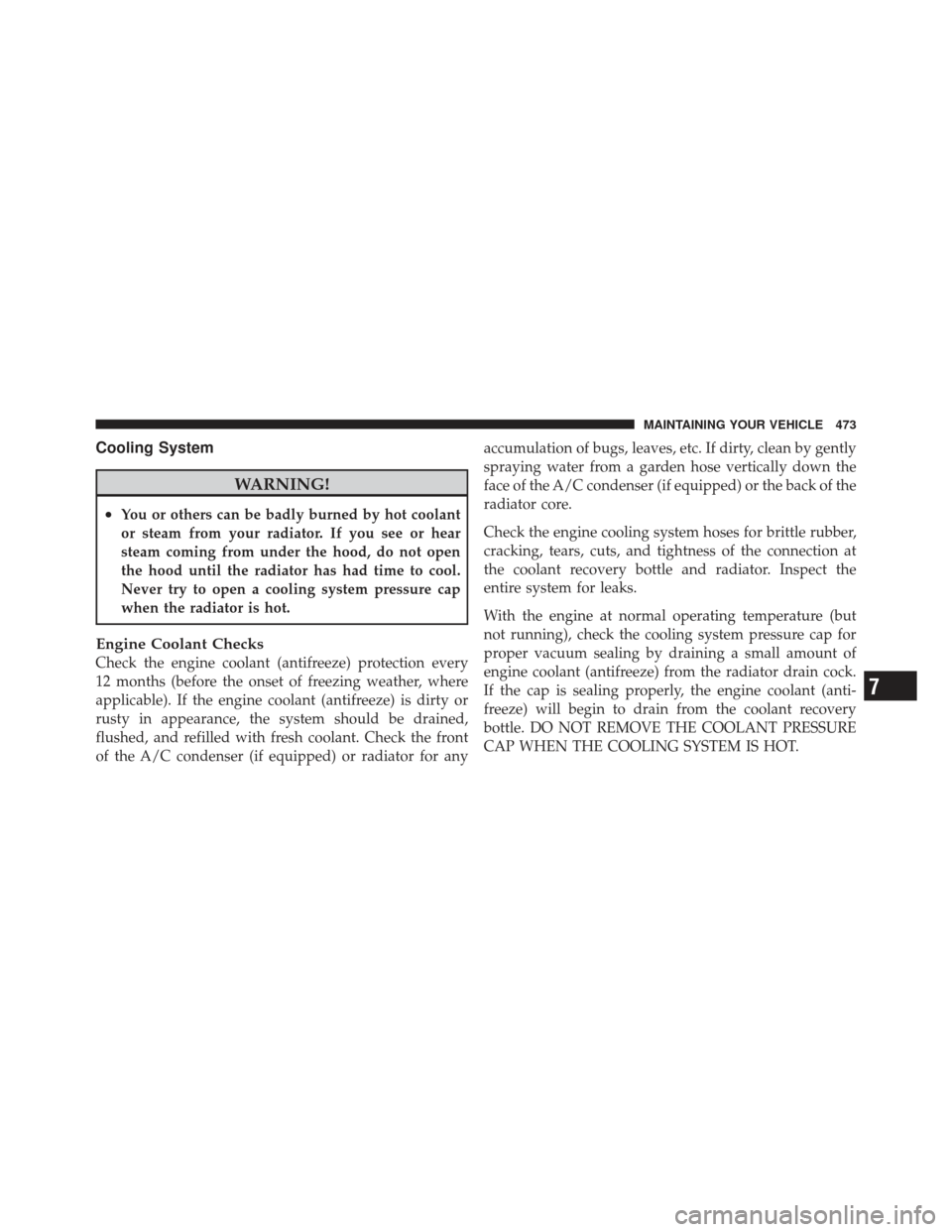
Cooling System
WARNING!
•You or others can be badly burned by hot coolant
or steam from your radiator. If you see or hear
steam coming from under the hood, do not open
the hood until the radiator has had time to cool.
Never try to open a cooling system pressure cap
when the radiator is hot.
Engine Coolant Checks
Check the engine coolant (antifreeze) protection every
12 months (before the onset of freezing weather, where
applicable). If the engine coolant (antifreeze) is dirty or
rusty in appearance, the system should be drained,
flushed, and refilled with fresh coolant. Check the front
of the A/C condenser (if equipped) or radiator for anyaccumulation of bugs, leaves, etc. If dirty, clean by gently
spraying water from a garden hose vertically down the
face of the A/C condenser (if equipped) or the back of the
radiator core.
Check the engine cooling system hoses for brittle rubber,
cracking, tears, cuts, and tightness of the connection at
the coolant recovery bottle and radiator. Inspect the
entire system for leaks.
With the engine at normal operating temperature (but
not running), check the cooling system pressure cap for
proper vacuum sealing by draining a small amount of
engine coolant (antifreeze) from the radiator drain cock.
If the cap is sealing properly, the engine coolant (anti-
freeze) will begin to drain from the coolant recovery
bottle. DO NOT REMOVE THE COOLANT PRESSURE
CAP WHEN THE COOLING SYSTEM IS HOT.
7
MAINTAINING YOUR VEHICLE 473
Page 478 of 558
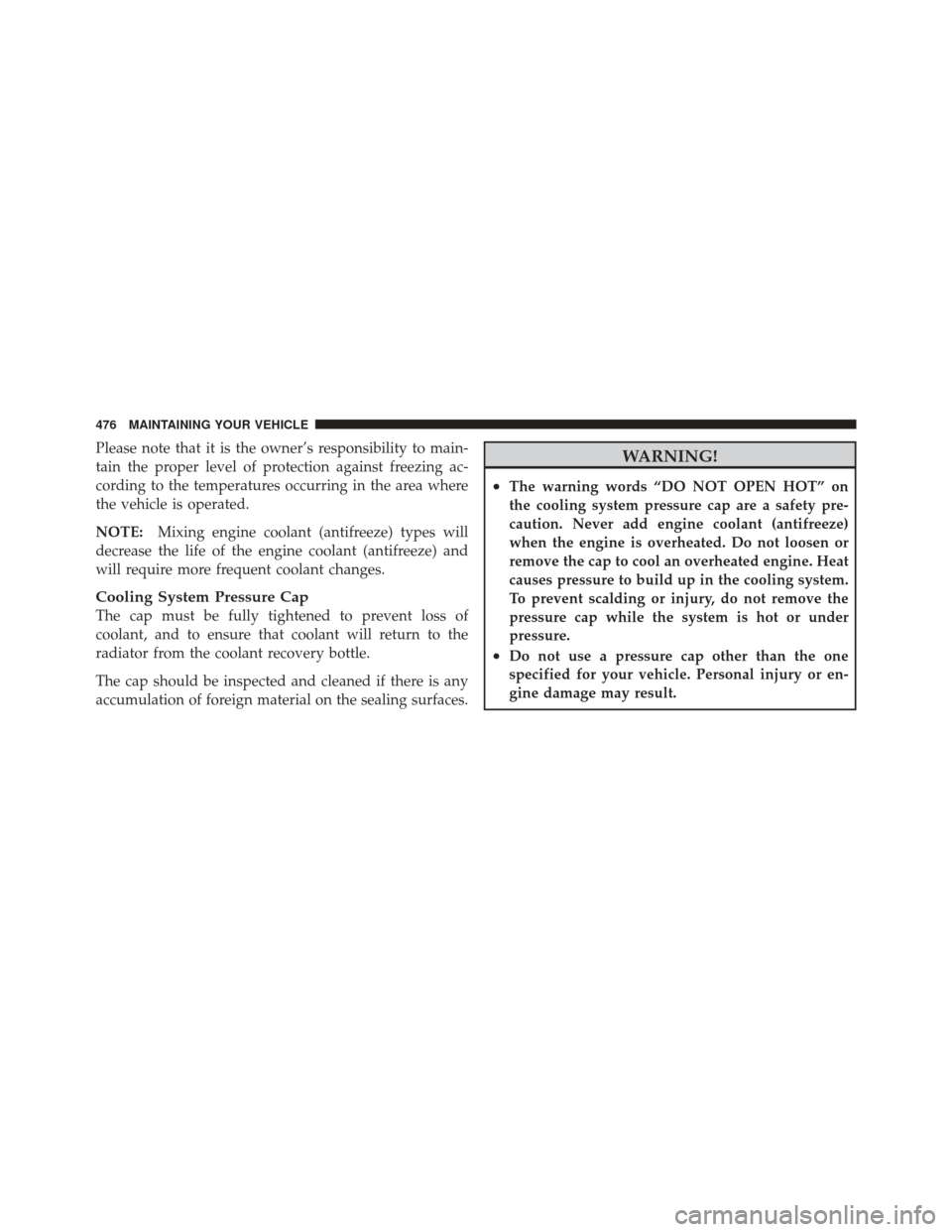
Please note that it is the owner’s responsibility to main-
tain the proper level of protection against freezing ac-
cording to the temperatures occurring in the area where
the vehicle is operated.
NOTE:Mixing engine coolant (antifreeze) types will
decrease the life of the engine coolant (antifreeze) and
will require more frequent coolant changes.
Cooling System Pressure Cap
The cap must be fully tightened to prevent loss of
coolant, and to ensure that coolant will return to the
radiator from the coolant recovery bottle.
The cap should be inspected and cleaned if there is any
accumulation of foreign material on the sealing surfaces.
WARNING!
•The warning words “DO NOT OPEN HOT” on
the cooling system pressure cap are a safety pre-
caution. Never add engine coolant (antifreeze)
when the engine is overheated. Do not loosen or
remove the cap to cool an overheated engine. Heat
causes pressure to build up in the cooling system.
To prevent scalding or injury, do not remove the
pressure cap while the system is hot or under
pressure.
•Do not use a pressure cap other than the one
specified for your vehicle. Personal injury or en-
gine damage may result.
476 MAINTAINING YOUR VEHICLE
Page 479 of 558
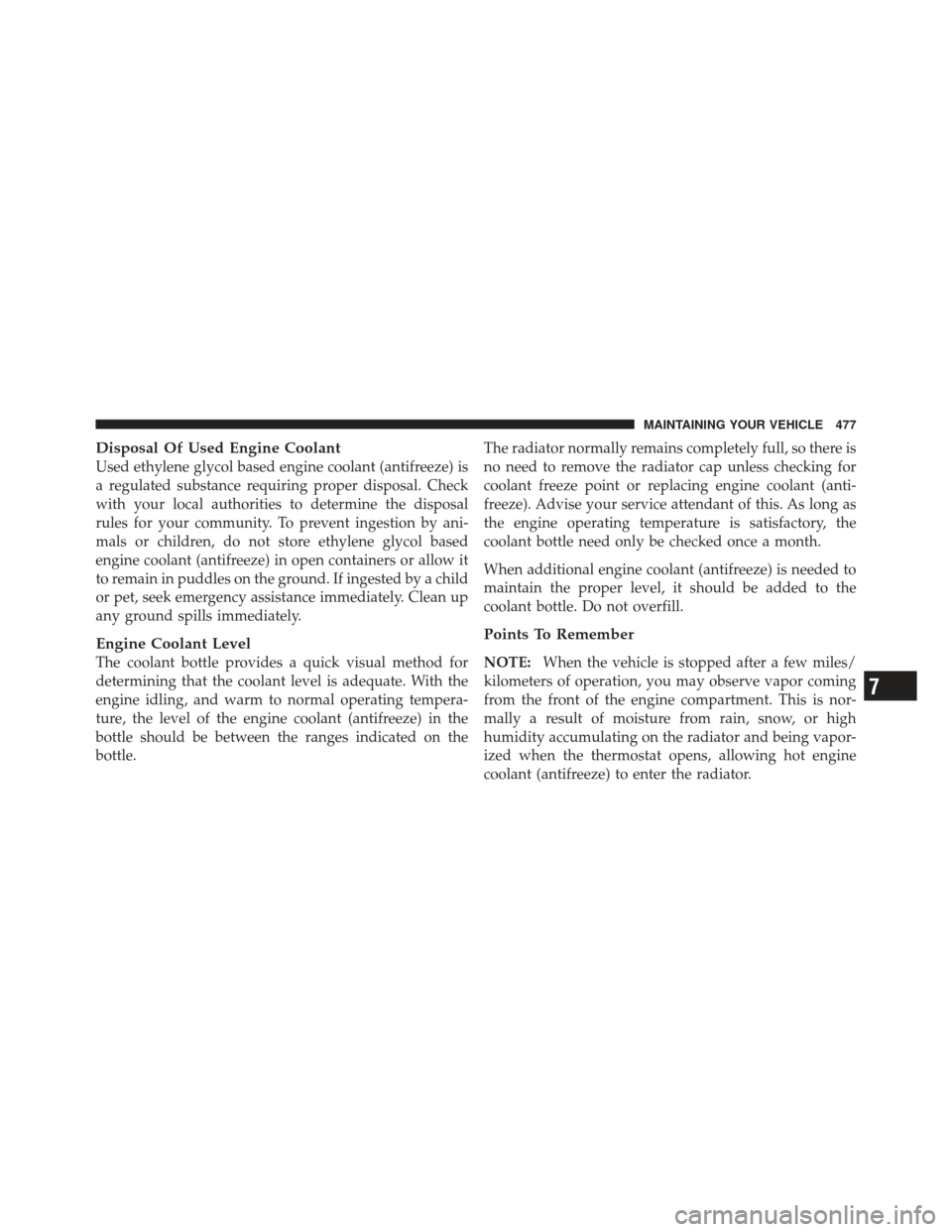
Disposal Of Used Engine Coolant
Used ethylene glycol based engine coolant (antifreeze) is
a regulated substance requiring proper disposal. Check
with your local authorities to determine the disposal
rules for your community. To prevent ingestion by ani-
mals or children, do not store ethylene glycol based
engine coolant (antifreeze) in open containers or allow it
to remain in puddles on the ground. If ingested by a child
or pet, seek emergency assistance immediately. Clean up
any ground spills immediately.
Engine Coolant Level
The coolant bottle provides a quick visual method for
determining that the coolant level is adequate. With the
engine idling, and warm to normal operating tempera-
ture, the level of the engine coolant (antifreeze) in the
bottle should be between the ranges indicated on the
bottle.The radiator normally remains completely full, so there is
no need to remove the radiator cap unless checking for
coolant freeze point or replacing engine coolant (anti-
freeze). Advise your service attendant of this. As long as
the engine operating temperature is satisfactory, the
coolant bottle need only be checked once a month.
When additional engine coolant (antifreeze) is needed to
maintain the proper level, it should be added to the
coolant bottle. Do not overfill.
Points To Remember
NOTE:
When the vehicle is stopped after a few miles/
kilometers of operation, you may observe vapor coming
from the front of the engine compartment. This is nor-
mally a result of moisture from rain, snow, or high
humidity accumulating on the radiator and being vapor-
ized when the thermostat opens, allowing hot engine
coolant (antifreeze) to enter the radiator.
7
MAINTAINING YOUR VEHICLE 477
Page 538 of 558
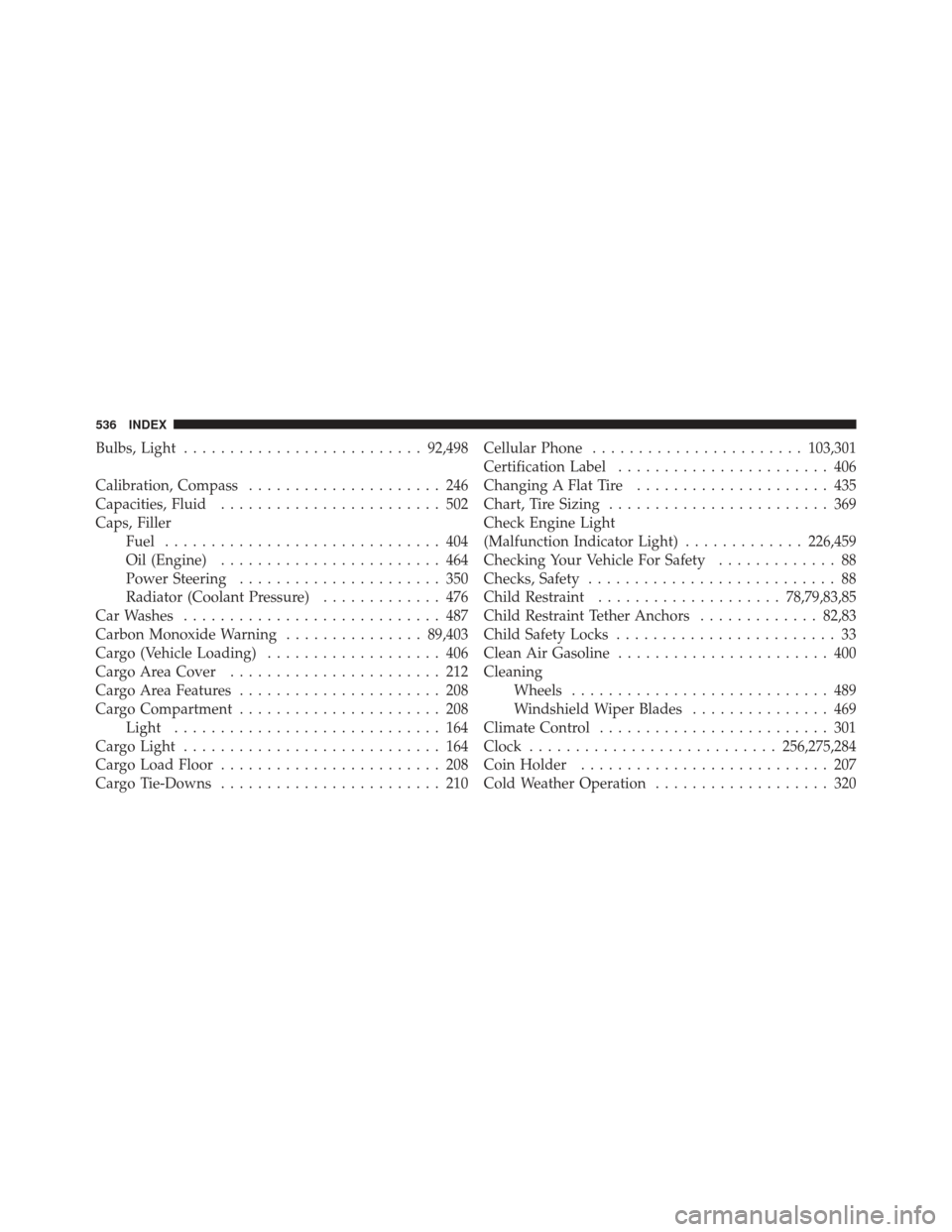
Bulbs, Light.......................... 92,498
Calibration, Compass ..................... 246
Capacities, Fluid ........................ 502
Caps, Filler Fuel .............................. 404
Oil (Engine) ........................ 464
Power Steering ...................... 350
Radiator (Coolant Pressure) ............. 476
Car Washes ............................ 487
Carbon Monoxide Warning ...............89,403
Cargo (Vehicle Loading) ................... 406
Cargo Area Cover ....................... 212
Cargo Area Features ...................... 208
Cargo Compartment ...................... 208
Light ............................. 164
Cargo Light ............................ 164
Cargo Load Floor ........................ 208
Cargo Tie-Downs ........................ 210 Cellular Phone
....................... 103,301
Certification Label ....................... 406
Changing A Flat Tire ..................... 435
Chart, Tire Sizing ........................ 369
Check Engine Light
(Malfunction Indicator Light) .............226,459
Checking Your Vehicle For Safety ............. 88
Checks, Safety ........................... 88
Child Restraint .................... 78,79,83,85
Child Restraint Tether Anchors .............82,83
Child Safety Locks ........................ 33
Clean Air Gasoline ....................... 400
Cleaning Wheels ............................ 489
Windshield Wiper Blades ............... 469
Climate Control ......................... 301
Clock ........................... 256,275,284
Coin Holder ........................... 207
Cold Weather Operation ................... 320
536 INDEX
Page 539 of 558
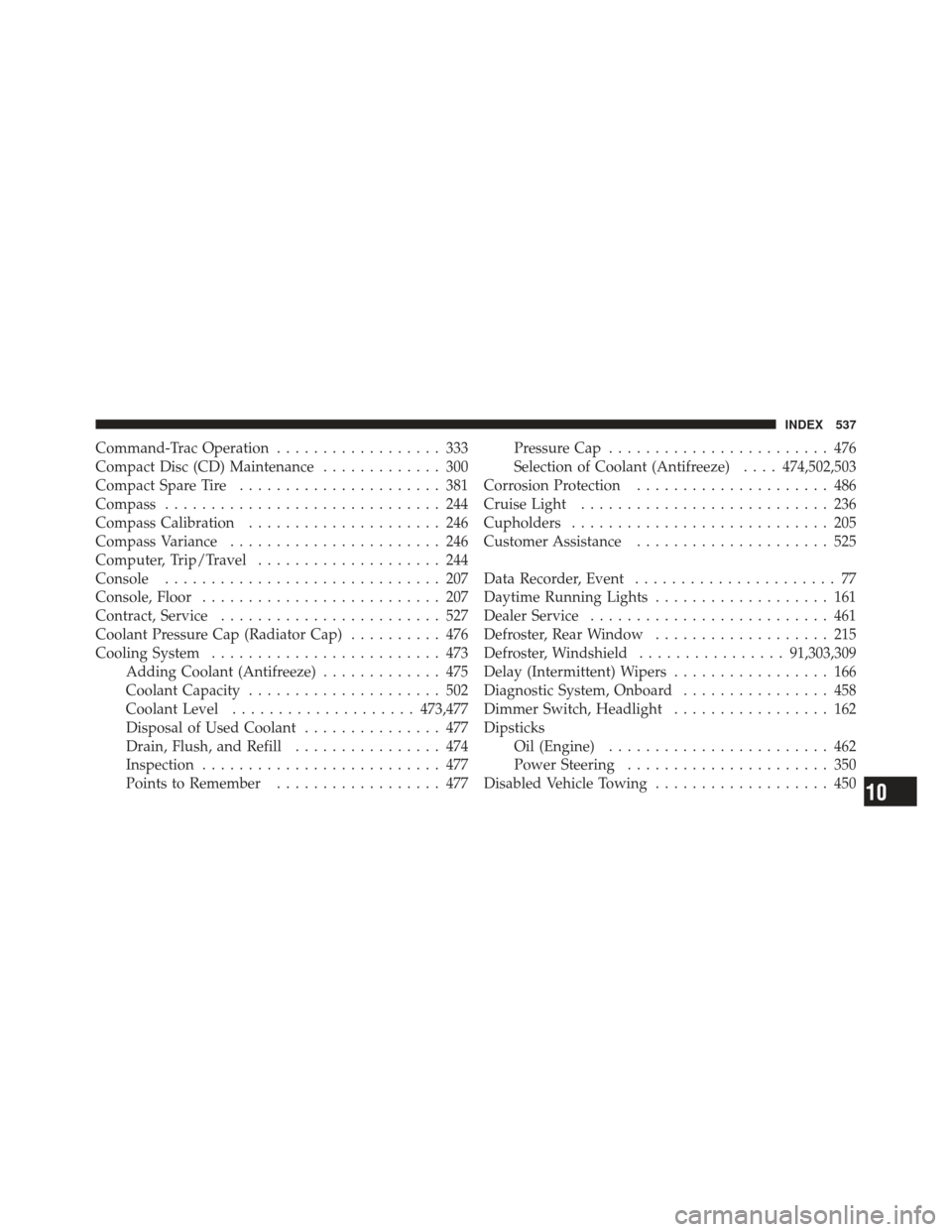
Command-Trac Operation.................. 333
Compact Disc (CD) Maintenance ............. 300
Compact Spare Tire ...................... 381
Compass .............................. 244
Compass Calibration ..................... 246
Compass Variance ....................... 246
Computer, Trip/Travel .................... 244
Console .............................. 207
Console, Floor .......................... 207
Contract, Service ........................ 527
Coolant Pressure Cap (Radiator Cap) .......... 476
Cooling System ......................... 473
Adding Coolant (Antifreeze) ............. 475
Coolant Capacity ..................... 502
Coolant Level .................... 473,477
Disposal of Used Coolant ............... 477
Drain, Flush, and Refill ................ 474
Inspection .......................... 477
Points to Remember .................. 477 Pressure Cap
........................ 476
Selection of Coolant (Antifreeze) ....474,502,503
Corrosion Protection ..................... 486
Cruise Light ........................... 236
Cupholders ............................ 205
Customer Assistance ..................... 525
Data Recorder, Event ...................... 77
Daytime Running Lights ................... 161
Dealer Service .......................... 461
Defroster, Rear Window ................... 215
Defroster, Windshield ................91,303,309
Delay (Intermittent) Wipers ................. 166
Diagnostic System, Onboard ................ 458
Dimmer Switch, Headlight ................. 162
Dipsticks Oil (Engine) ........................ 462
Power Steering ...................... 350
Disabled Vehicle Towing ................... 450
10
INDEX 537
Page 549 of 558
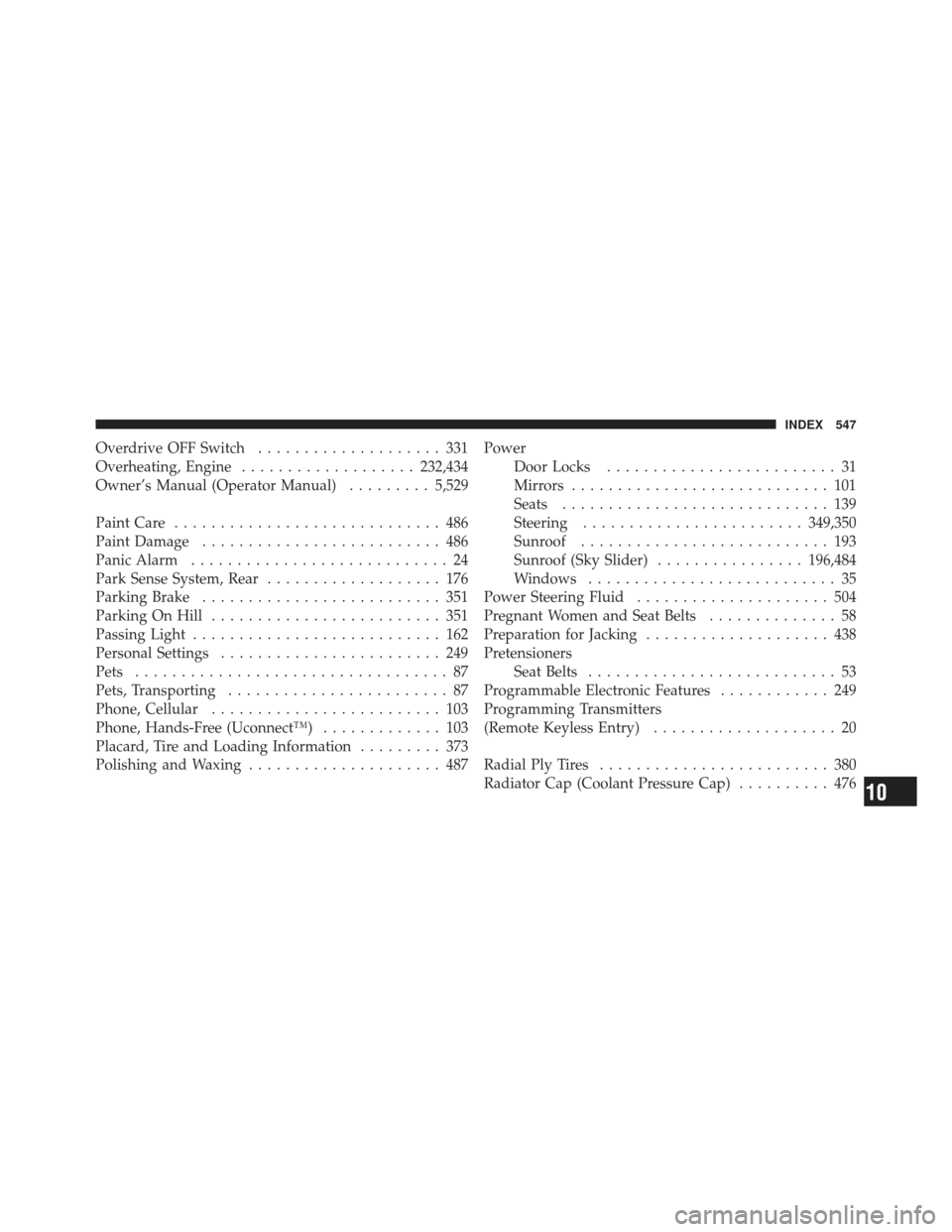
Overdrive OFF Switch.................... 331
Overheating, Engine ................... 232,434
Owner’s Manual (Operator Manual) .........5,529
Paint Care ............................. 486
Paint Damage .......................... 486
Panic Alarm ............................ 24
Park Sense System, Rear ................... 176
Parking Brake .......................... 351
Parking On Hill ......................... 351
Passing Light ........................... 162
Personal Settings ........................ 249
Pets .................................. 87
Pets, Transporting ........................ 87
Phone, Cellular ......................... 103
Phone, Hands-Free (Uconnect™) ............. 103
Placard, Tire and Loading Information ......... 373
Polishing and Waxing ..................... 487 Power
Door Locks ......................... 31
Mirrors ............................ 101
Seats ............................. 139
Steering ........................ 349,350
Sunroof ........................... 193
Sunroof (Sky Slider) ................ 196,484
Windows ........................... 35
Power Steering Fluid ..................... 504
Pregnant Women and Seat Belts .............. 58
Preparation for Jacking .................... 438
Pretensioners Seat Belts ........................... 53
Programmable Electronic Features ............ 249
Programming Transmitters
(Remote Keyless Entry) .................... 20
Radial Ply Tires ......................... 380
Radiator Cap (Coolant Pressure Cap) .......... 476
10
INDEX 547